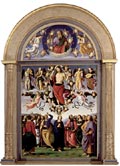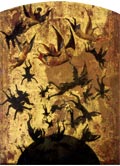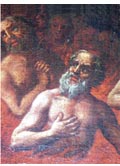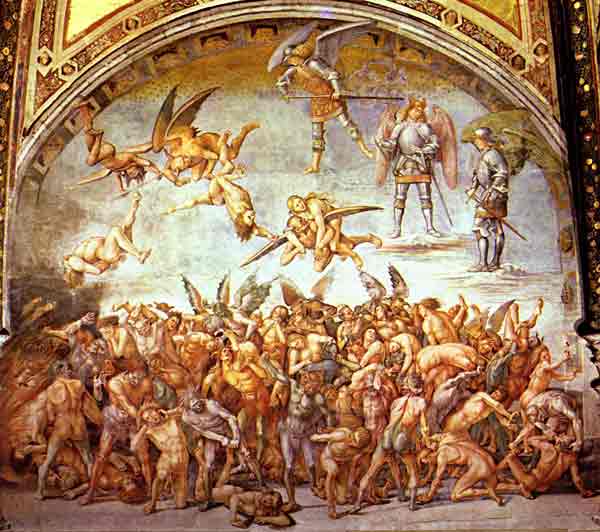 |
|
|
||||||
|
|
||||||
 |
||||||
 |
 |
 |
 |
 |
 |
 |
|
Thanks to the insight of fifteen-year-old Blessed Carlo Acutis, who died in the concept of sanctity in October 2006 (www.carloacutis.com), and to the generous and accurate research completed by the writer and journalist Nicola Gori, who also drew from various historical documents in the "Positiones" of persons whose cause for canonization is maintained by the Congregation of the Causes of the Saints, it was made possible to achieve this exhibition which presents 160 testimonies of Saints and of Mystics who have had visions of the Inferno (Hell), of Purgatory, and of Paradise. The exhibition is the fruit of careful and thorough research carried out on an international scale. The young Carlo was profoundly convinced that the rampant spread of sin in our times and the consequential loss of innumerable souls, are very often due to the disappearance of preaching on the Last Things. The experiences collected embrace all the centuries of the Christian era. Through this exhibition the visitors will be confirmed in the truth of the existence of the Inferno, of Purgatory, and of Paradise, the reality to which each person is called to after death. One is only left to visit the exhibit and immerse themselves with an open mind to the solicitations which these episodes provoke. What Happens with and After Death?Where does death have its origins?God has neither willed nor created death in the manner we endure it today. Death entered the world as a result of the first sin of our ancestors, Adam and Eve. It is therefore the “wages of sin” (Rm 6: 23). What is the meaning of death?Today one tends to censor and remove this reality of human life. Just the thought of death itself creates anguish. By not thinking of it, one believes in keeping it away or overcoming it. In reality, death which is inexorable, comes and can come in any condition in which one finds oneself. For every human being, death is:
For a Christian, death is enlightened by the Word of God and offers light than brightens and consoles. In this manner, death becomes:
What happens with death?With death, one verifies the separation of body and soul. Man’s body gets corrupted, while his soul, which is immortal, goes to meet God in order to be judged. It will be reunited to its body at the end of time. What does it mean to die in God's grace?It means to die with the awareness of not having mortal sin on one’s soul. It means to die in peace with God and with one’s neighbour. “This word is certain: if we die with Him, we will live with Him” (2 Tim 2: 11). How is it possible to die with Christ?
How has Christ conquered death?By destroying the cause of death, i.e. sin, with His Death on the cross and with His Resurrection. How can one describe the conditions of man after death?“It is necessary to avoid imaginary and arbitrary representations which, instead of helping, deepen the difficulties of the Christian Faith. The images used by Sacred Scripture nevertheless merit respect. One needs to draw out from them the deep meaning, by avoiding the risk of attenuating them too much and emptying the realities which they manifest from their substance” (Congregation for the Doctrine of the Faith, Letter regarding some eschatological questions). What happens after death?The soul, separated from the body, is judged by God in relationship with the Faith and with one’s deeds. This is the specific judgment, with which the immediate remuneration is given to each one for his eternal life. Such a remuneration consists of having access to:
What is Paradise?Paradise is the state of full and definitive happiness. This happiness consists of seeing God “just as He is” (1 Jn 3:2), “face to face” (1 Cor 13: 12). God will then be known and loved as the maximum, supreme happiness of man, the ultimate end and full realization of the deepest aspirations of man. This mystery of the beatific vision, of the beatific communion with God and with all those who are in Christ, goes beyond every possibility of comprehension and description. Sacred Scripture speaks to us about it with some images: life, light, peace, wedding banquet, the Father’s house, heavenly Jerusalem… What is Purgatory?Purgatory is the purification of those who die in God’s grace, and therefore are already sure of being able to enter Paradise, but need further purification in order to obtain the holiness necessary to enter the joy of Paradise. How can we help such a purification?
What is Hell?
Hell is the eternal damnation of those, who due to their free choice, die in mortal sin without repenting for it and without accepting the merciful love of God. Jesus expresses such a reality with some images: Gehenna, inextinguishable fire, burning furnace… They are images to describe the state of extreme suffering and of eternal damnation which affect those who are in hell; The main punishment of hell consists of eternal separation from God: only in Him in fact man can have life and happiness, for which he has been created and to which he aspires. God does not predestine anyone to go to hell. Rather He, as a good Father, desires that everyone be saved and reach His Home: Paradise. He therefore sent His Son who died and was raised. He does not want “that anyone should perish, but that all should come to repentance” (2 Pt 3: 9). He thus wants that every single person during his earthly life either kindly (benevolently) or sometimes even in a strong manner (as every good father does with his own son). And nevertheless, having created man free, God respects the decisions of every person, especially in the crucial moment of his death. Therefore it is man himself who, in full freedom and responsibility, excludes himself from Paradise and, by persisting in his radical refusal of God, merits hell. What is the Final Universal Judgment?It is the judgment that God will give at the end of time, at the end of the world, when Christ “will come in glory with all his angels […]. And all the peoples will be reunited in front of him, and he will separate one from the other […]. And those will be sent to eternal torture, and the just to eternal life” (Mt 25:31-46). With this judgment:
When will the Final Judgment take place?Only God knows the day and the hour of such a definitive event. We only know that it will take place “on the last day” (Jn 6:39), at the end of this world. On what is our faith regarding the resurrection of our body founded?It is founded:
How will the resurrection of our bodies take place?To know the way in which the resurrection takes place goes beyond the possibilities of our intellect. It is accessible only in the Faith. What is the difference between resurrection of the body and reincarnation?There exists an enormous difference between the two, in so far as:
In what sense does a Christian die and rise to new life every day?Every day of one’s life here on earth is, for a Christian, a participation in the Death and in the Resurrection of Christ, from a:
S.E. Monsignor Raffaello Martinelli NB: per approfondire l’argomento, si leggano anche i seguenti documenti pontifici:
ESCHATOLOGY. The branch of systematic theology that treats of the last things: death, particular and general judgments, heaven, hell, and purgatory. All the essentials of eschatology have been clearly defined by the Church, notably the Fourth Lateran Council (1215) and the constitution Benedictus Deus of Pope Benedict XII in 1336. (Etym. Greek eschatos, uttermost + logos, discourse on.) (Father John A. Hardon, S.J. Modern Catholic Dictionary)
|
||||||||||||||||||
Italiano - Inferno, Purgatorio, Paradiso
|
To host the Paradise, Hell, Purgatory exhibition, you need to obtain a set of high definition PDFs to print the posters. You may request a DVD from the: |
|
|
Real Presence Eucharistic Education and Adoration Association |
|
Please be sure to include your name, address and phone number with your request. | |
|
In cooperation with Antonia Salzano Acutis,
|
Adorers Society | PEA Manual | Essentials of Faith | Dictionary | Thesaurus | Catalog | Newsletters
|
Real Presence Eucharistic Education and Adoration Association
718 Liberty Lane Lombard, IL 60148 Phone: 815-254-4420 Contact Us Internet: www.therealpresence.org Copyright © 2000 by www.therealpresence.org All rights reserved worldwide. No part of this publication may be reproduced, stored in a retrieval system, or transmitted, in any form or by any means, electronic, mechanical, photocopying, recording or otherwise, without the prior written permission of www.therealpresence.org |